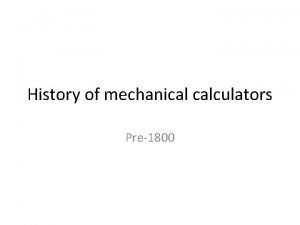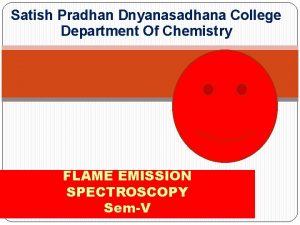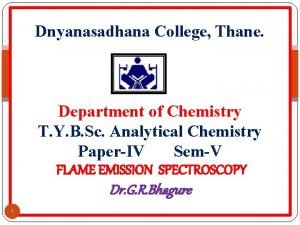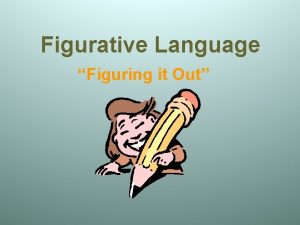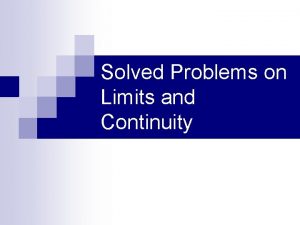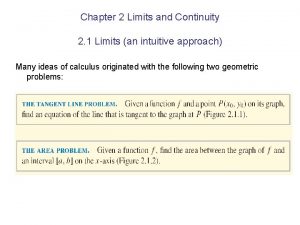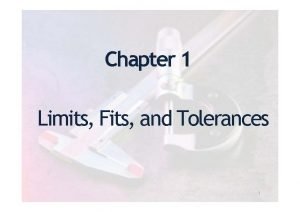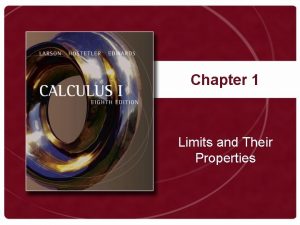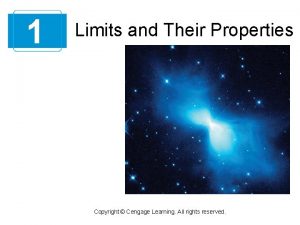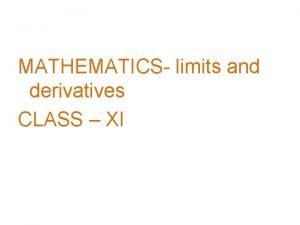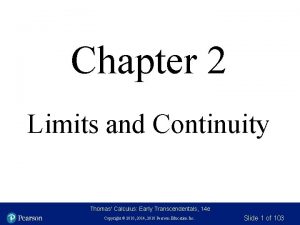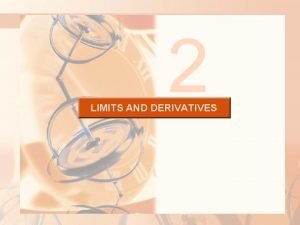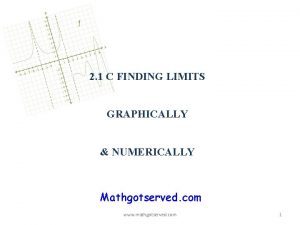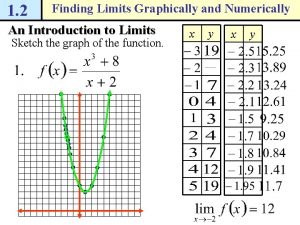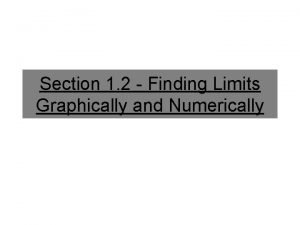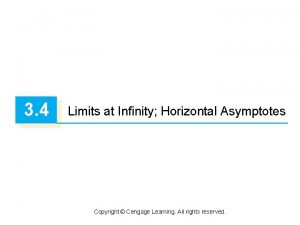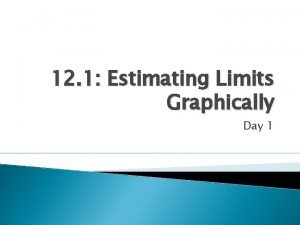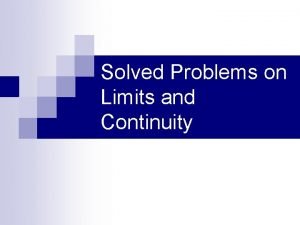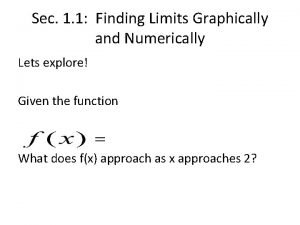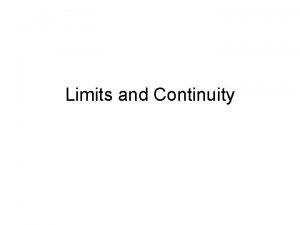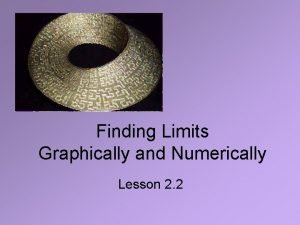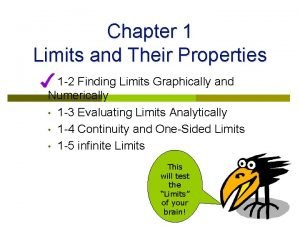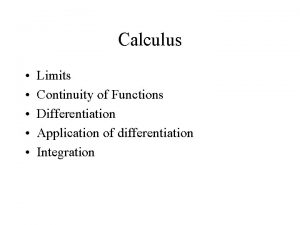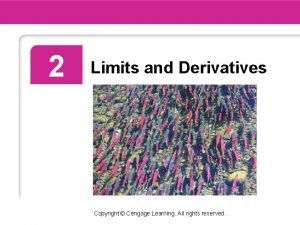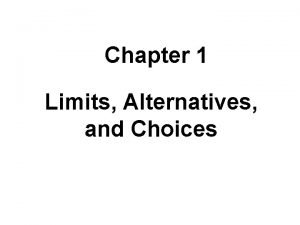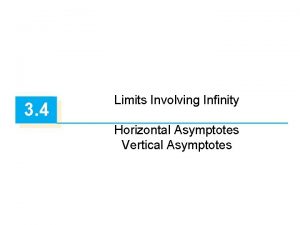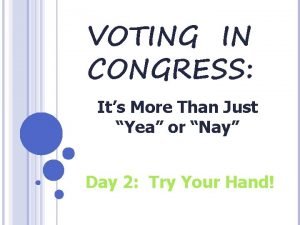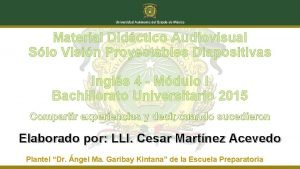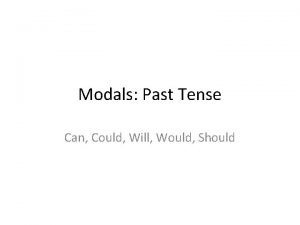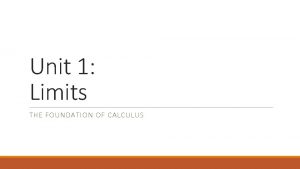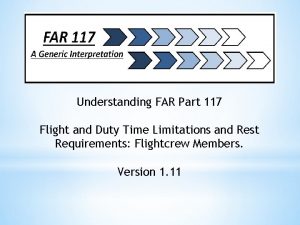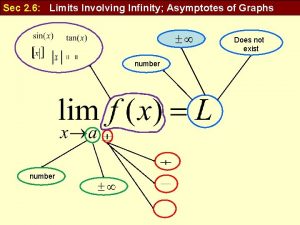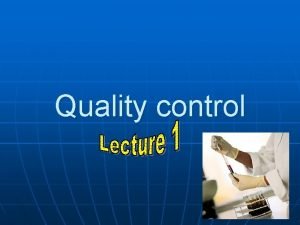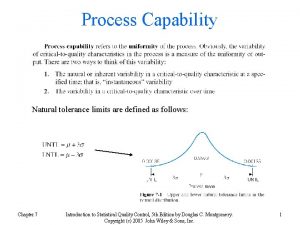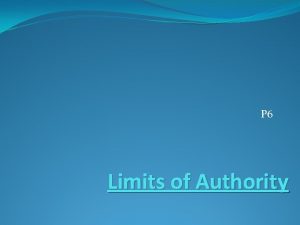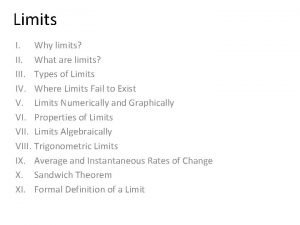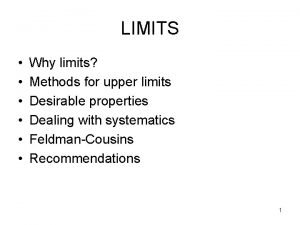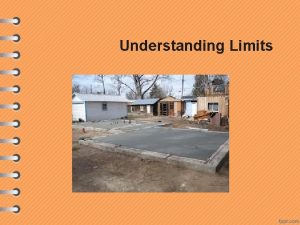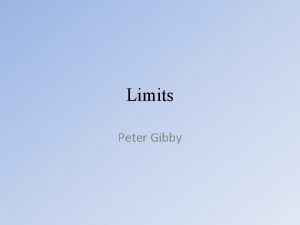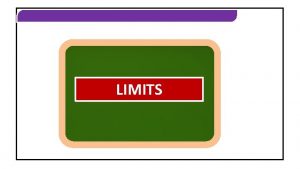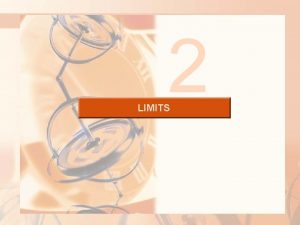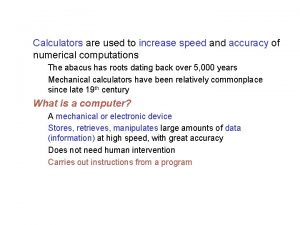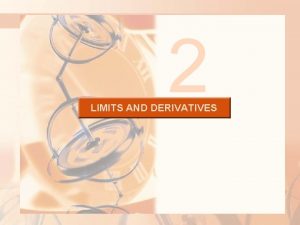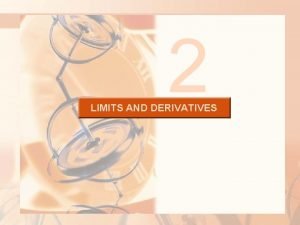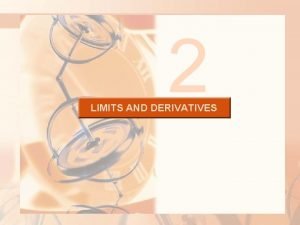2 LIMITS LIMITS We have used calculators and




























































- Slides: 60

2 LIMITS

LIMITS We have used calculators and graphs to guess the values of limits. § However, we have learned that such methods don’t always lead to the correct answer.

LIMITS 2. 3 Calculating Limits Using the Limit Laws In this section, we will: Use the Limit Laws to calculate limits.

THE LIMIT LAWS Suppose that c is a constant and the limits and exist.

THE LIMIT LAWS Then,

THE LIMIT LAWS These laws can be stated verbally, as follows.

THE SUM LAW The limit of a sum is the sum of the limits.

THE DIFFERENCE LAW The limit of a difference is the difference of the limits.

THE CONSTANT MULTIPLE LAW The limit of a constant times a function is the constant times the limit of the function.

THE PRODUCT LAW The limit of a product is the product of the limits.

THE QUOTIENT LAW The limit of a quotient is the quotient of the limits (provided that the limit of the denominator is not 0).

THE LIMIT LAWS It is easy to believe that these properties are true. § For instance, if f(x) is close to L and g(x) is close to M, it is reasonable to conclude that f(x) + g(x) is close to L + M. § This gives us an intuitive basis for believing that the Sum Law is true. § In Section 2. 4, we give a precise definition of a limit and use it to prove this law.

USING THE LIMIT LAWS Example 1 Use the Limit Laws and the graphs of f and g in the figure to evaluate the following limits, if they exist. a. b. c.

USING THE LIMIT LAWS Example 1 a From the graphs, we see that and. § Therefore, we have:

USING THE LIMIT LAWS Example 1 b We see that. However, does not exist—because the left and right limits are different: and § So, we can’t use the Product Law for the desired limit.

USING THE LIMIT LAWS Example 1 b However, we can use the Product Law for the one-sided limits: and § The left and right limits aren’t equal. § So, does not exist.

USING THE LIMIT LAWS Example 1 c The graphs show that and. As the limit of the denominator is 0, we can’t use the Quotient Law. § does not exist. § This is because the denominator approaches 0 while the numerator approaches a nonzero number.

THE POWER LAW If we use the Product Law repeatedly with f(x) = g(x), we obtain the Power Law. where n is a positive integer

USING THE LIMIT LAWS In applying these six limit laws, we need to use two special limits. § These limits are obvious from an intuitive point of view. § State them in words or draw graphs of y = c and y = x.

USING THE LIMIT LAWS If we now put f(x) = x in the Power Law and use Law 8, we get another useful special limit. where n is a positive integer.

USING THE LIMIT LAWS A similar limit holds for roots. where n is a positive integer. § If n is even, we assume that a > 0.

THE ROOT LAW More generally, we have the Root Law. where n is a positive integer. § If n is even, we assume that .

USING THE LIMIT LAWS Example 2 Evaluate the following limits and justify each step. a. b.

USING THE LIMIT LAWS Example 2 a (by Laws 2 and 1) (by Law 3) (by Laws 9, 8, and 7)

USING THE LIMIT LAWS Example 2 b We start by using the Quotient Law. However, its use is fully justified only at the final stage. § That is when we see that the limits of the numerator and denominator exist and the limit of the denominator is not 0.

USING THE LIMIT LAWS Example 2 b (by Law 5) (by Laws 1, 2, and 3) (by Laws 9, 8, and 7)

USING THE LIMIT LAWS If we let f(x) = then f(5) = 39. Note 2 2 x - 3 x + 4, § In other words, we would have gotten the correct answer in Example 2 a by substituting 5 for x. § Similarly, direct substitution provides the correct answer in Example 2 b.

USING THE LIMIT LAWS Note The functions in the example are a polynomial and a rational function, respectively. § Similar use of the Limit Laws proves that direct substitution always works for such functions.

DIRECT SUBSTITUTION PROPERTY We state this fact as follows. If f is a polynomial or a rational function and a is in the domain of f, then

DIRECT SUBSTITUTION PROPERTY Functions with the Direct Substitution Property are called ‘continuous at a. ’ However, not all limits can be evaluated by direct substitution—as the following examples show.

USING THE LIMIT LAWS Example 3 Find § Let f(x) = (x 2 - 1)/(x - 1). § We can’t find the limit by substituting x = 1, because f(1) isn’t defined. § We can’t apply the Quotient Law, because the limit of the denominator is 0. § Instead, we need to do some preliminary algebra.

USING THE LIMIT LAWS Example 3 We factor the numerator as a difference of squares. § The numerator and denominator have a common factor of x - 1. § When we take the limit as x approaches 1, we have and so.

USING THE LIMIT LAWS Example 3 § Therefore, we cancel the common factor and compute the limit as follows:

USING THE LIMIT LAWS Example 3 The limit in the example arose in Section 2. 1 when we were trying to find the tangent to the parabola y = x 2 at the point (1, 1).

USING THE LIMIT LAWS Note In the example, we were able to compute the limit by replacing the given function f(x) = (x 2 - 1)/(x - 1) by a simpler function with the same limit, g(x) = x + 1. § This is valid because f(x) = g(x) except when x = 1 and, in computing a limit as x approaches 1, we don’t consider what happens when x is actually equal to 1.

USING THE LIMIT LAWS Note In general, we have the following useful fact. If f(x) = g(x) when , then , provided the limits exist.

USING THE LIMIT LAWS Find Example 4 where § Here, g is defined at x = 1 and. § However, the value of a limit as x approaches 1 does not depend on the value of the function at 1. § Since g(x) = x + 1 for , we have: .

USING THE LIMIT LAWS Note that the values of the functions in Examples 3 and 4 are identical except when x = 1. So, they have the same limit as x approaches 1.

USING THE LIMIT LAWS Example 5 Evaluate § If we define , we can’t compute by letting h = 0 since F(0) is undefined. § However, if we simplify F(h) algebraically, we find that:

USING THE LIMIT LAWS Example 5 § Recall that we consider only when letting h approach 0. § Thus,

USING THE LIMIT LAWS Example 6 Find § We can’t apply the Quotient Law immediately—since the limit of the denominator is 0. § Here, the preliminary algebra consists of rationalizing the numerator.

USING THE LIMIT LAWS § Thus, Example 6

USING THE LIMIT LAWS Theorem 1 Some limits are best calculated by first finding the left- and right-hand limits. The following theorem states that a two-sided limit exists if and only if both the one-sided limits exist and are equal. if and only if § When computing one-sided limits, we use the fact that the Limit Laws also hold for one-sided limits.

USING THE LIMIT LAWS Example 7 Show that § Recall that: § Since |x| = x for x > 0 , we have: § Since |x| = -x for x < 0, we have: § Therefore, by Theorem 1, .

USING THE LIMIT LAWS Example 7 The result looks plausible from the figure.

USING THE LIMIT LAWS Prove that Example 8 does not exist. § Since the right- and left-hand limits are different, it follows from Theorem 1 that does not exist.

USING THE LIMIT LAWS Example 8 The graph of the function is shown in the figure. It supports the one-sided limits that we found.

USING THE LIMIT LAWS Example 9 If determine whether § Since exists. for x > 4, we have: § Since f(x) = 8 - 2 x for x < 4, we have:

USING THE LIMIT LAWS Example 9 § The right- and left-hand limits are equal. § Thus, the limit exists and.

USING THE LIMIT LAWS Example 9 The graph of f is shown in the figure.

GREATEST INTEGER FUNCTION Example 10 The greatest integer function is defined by = the largest integer that is less than or equal to x. § For instance, , , and § The greatest integer function is sometimes called the floor function. .

GREATEST INTEGER FUNCTION Example 10 Show that does not exist. § The graph of the greatest integer function is shown in the figure.

GREATEST INTEGER FUNCTION Example 10 § Since for , we have: § As these one-sided limits are not equal, does not exist by Theorem 1.

USING THE LIMIT LAWS The next two theorems give two additional properties of limits.

PROPERTIES OF LIMITS Theorem 2 If when x is near a (except possibly at a) and the limits of f and g both exist as x approaches a, then

SQUEEZE THEOREM Theorem 3 The Squeeze Theorem states that, if when x is near (except possibly at a) and , then § The Squeeze Theorem is sometimes called the Sandwich Theorem or the Pinching Theorem.

SQUEEZE THEOREM The theorem is illustrated by the figure. § It states that, if g(x) is squeezed between f(x) and h(x) near a and if f and h have the same limit L at a, then g is forced to have the same limit L at a.

USING THE LIMIT LAWS Example 11 Show that § Note that we cannot use § This is because does not exist.

USING THE LIMIT LAWS § However, since we have: § This is illustrated by the figure. Example 11 ,

USING THE LIMIT LAWS § We know that: Example 11 and § Taking f(x) = -x 2, , and h(x) = x 2 in the Squeeze Theorem, we obtain:
 Http://www.finaid.org/calculators/loanpayments.phtml
Http://www.finaid.org/calculators/loanpayments.phtml Ancient calculators
Ancient calculators Lim as x approaches infinity
Lim as x approaches infinity Real limits statistics
Real limits statistics 6 square faces 8 vertices
6 square faces 8 vertices Speech success criteria
Speech success criteria Words have meaning and names have power
Words have meaning and names have power Some animals are dangerous *
Some animals are dangerous * What is a echinoderm
What is a echinoderm In a premix burner used in fes the fuel used is
In a premix burner used in fes the fuel used is In a premix burner used in fes the fuel used is
In a premix burner used in fes the fuel used is Which seedless plants have been used to treat bee stings?
Which seedless plants have been used to treat bee stings? Dinner is on the house figurative language
Dinner is on the house figurative language The druids may have used stonehenge dgp
The druids may have used stonehenge dgp I'd rather take baths with a man-eating shark
I'd rather take baths with a man-eating shark Which seedless plants have been used to treat burns
Which seedless plants have been used to treat burns Limits and continuity problems with solutions
Limits and continuity problems with solutions Limits fits and tolerances lecture notes
Limits fits and tolerances lecture notes Radiation dose limits for workers and public pdf
Radiation dose limits for workers and public pdf Calculus chapter 2 limits and continuity
Calculus chapter 2 limits and continuity Fits and tolerance شرح
Fits and tolerance شرح Limits and their properties
Limits and their properties Limits and their properties
Limits and their properties Fits and tolerances chart
Fits and tolerances chart Limits and derivatives class 11 pdf
Limits and derivatives class 11 pdf Thomas calculus limits and continuity
Thomas calculus limits and continuity Plasticity index chart of soil
Plasticity index chart of soil Limits and derivatives
Limits and derivatives Lesson 2: understanding limits graphically and numerically
Lesson 2: understanding limits graphically and numerically Finding limits graphically
Finding limits graphically Finding limits graphically and numerically
Finding limits graphically and numerically Vertical asymptote
Vertical asymptote Estimating limit values from tables
Estimating limit values from tables Limits and continuity
Limits and continuity Evaluating limits graphically
Evaluating limits graphically Limits and continuity
Limits and continuity Analyzing limits graphically
Analyzing limits graphically Chapter 1 limits and their properties
Chapter 1 limits and their properties Limits of composite functions
Limits of composite functions Application of limits and continuity
Application of limits and continuity Limits and derivatives
Limits and derivatives Society's economizing problem involves
Society's economizing problem involves Vertical and horizontal asymptotes limits
Vertical and horizontal asymptotes limits Bill a no mail on saturdays worksheet answers
Bill a no mail on saturdays worksheet answers Modals of deduction شرح
Modals of deduction شرح They did not reject you they rejected me
They did not reject you they rejected me I have resolved
I have resolved Ideas have consequences bad ideas have victims
Ideas have consequences bad ideas have victims Have been to or have gone to
Have been to or have gone to Past of can
Past of can Et-500 gate motor programming
Et-500 gate motor programming Limits calculator
Limits calculator Part 117 flight time limits
Part 117 flight time limits The limits of quantum computers
The limits of quantum computers Limits involving infinity asymptotes of graphs
Limits involving infinity asymptotes of graphs Royal london medical underwriting limits
Royal london medical underwriting limits How to calculate control limits
How to calculate control limits Content uniformity definition
Content uniformity definition Natural tolerance limits definition
Natural tolerance limits definition Pnenumbra
Pnenumbra Examples of limits of authority
Examples of limits of authority

